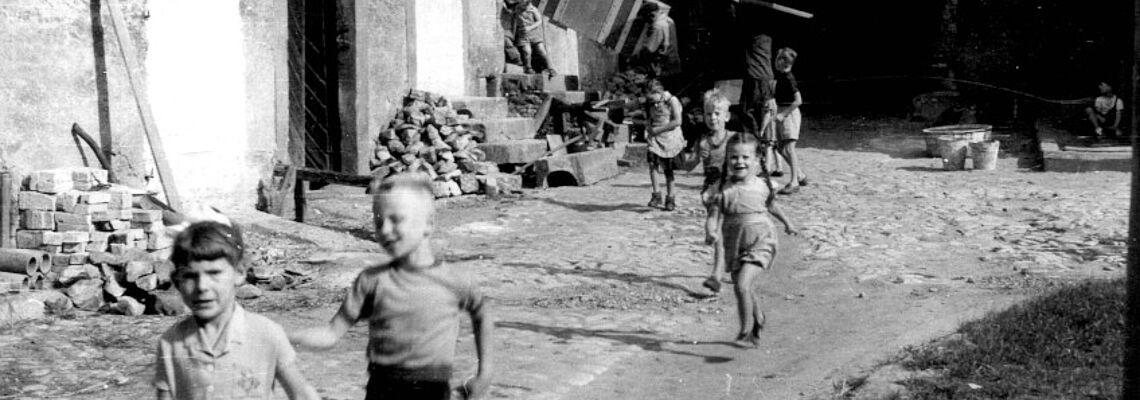In 1924, a local history museum was opened in the castle at the endeavor of the 'Heimatverein im alten Holzkreis', from which the present Börde Museum emerged. Two rooms in the castle Ummendorf were used. Other users of the castle were the municipality of Ummendorf, a kindergarden and a school (today Ummendorf Castle Elementary School). A. Hansen made efforts as honorary museum director and laid the foundation for today's cultural-historical, ethnological, geological and archaeological collection. He published articles on regional history in newspapers and magazines.
With the Second World War, the Ummendorf Museum was also closed, the objects, the library and the documentation of the holdings were removed/stored (attic and privately at A. Hansen). Fortunately, major losses were avoided.
In the late 1940s, an initiative arose to reopen the museum as a district museum (Kreis Haldensleben). This was advocated because of its rich and "unique" collection holdings. After the district reform (1952) Ummendorf belonged to the district of Wanzleben. The council of the district of Wanzleben took over the sponsorship of the museum. The introduction of a full-time position (Heinz Nowak) led to the expansion of the permanent exhibition, library and regional archive. This also included extensions of the holdings. This included private donations as well as the acquisition of objects from dissolved museums and local history rooms (Heimatstuben Wanzleben and Seehausen). Among the additions from the 1950s and 1960s, there are also references to objects from the land reform (450 objects). In 1963, the estate of Albert Hansen was transferred to the museum (archive).
In the following decades, the museum continued to develop. Exhibition areas in the outdoor facilities were created, events were founded and the collection was repeatedly published scientifically. A herb garden was established in the western moat (from 1979/80). The sculpture garden was established in the eastern moat. Archaeological excavations with the participation of the museum took place on the grounds. Castle summer concerts (since 1978) and an annual artists' symposium (1975 to 1985) were established. Extensive renovations (tower, courtyard paving, etc.) took place in the 1970s and 1980s. The changes at the castle/museum were supported by the gain of space (removal of the kindergarden, abandonment of the castle as living space 1980s).
In the 1990s, the then director (Thomas Ruppel) initiated other large events in addition to the already existing castle summer concerts, not least to acquire income. The museum developed into the largest organizer in the southern part of the district: Christmas market, herbs in pots, castle feast, craft market, meetings of historical vehicles and agricultural technology as well as the herb garden festival.
The focus of the museum's work in the permanent exhibition was in the 1990s until 2011 in the outdoor facilities. The Memleben - Thomas Münzer collection (agricultural technology) came to Ummendorf as a permanent loan from the state of Saxony-Anhalt. In 1998, the roofing of the agricultural technology exhibition, financed with state funds, was erected. The Oschersleben and Ummendorf museums complemented each other with regard to the agricultural technology collection. When the Oschersleben museum was closed in 2003, the Börde Museum took over large parts of the holdings. Today, a part of the cultural-historical collection can also be found in the exhibition of the municipal museum of Oschersleben. The agricultural technology collection was already transferred to the Ummendorf Museum in the 1990s. New exhibition areas were created in the herb garden in 2006 and 2011 with the Medieval Garden and the Baroque Garden.
In 2013, the Nowak scientific estate was transferred to the museum archive. Further collection expansions in the main topics: Brewery, Agricultural Technology and Cultural Property required large-scale expansions of the storage areas (currently 2022 there are 6 collection magazines).
In 2012-2014, with funding from the ESF, the state and the district, it was possible to carry out a partial modernization of the museum. A renovation of the building fabric was started and a more visitor-friendly environment was created. A new entrance was designed, and the focus was also on fire protection measures and the installation of a new escape route. An extension of the exhibition areas (approx. 70 sqm) allowed a revision of the visitors' tour.
Through an active acquisition of funds between 2016 and 2021, around 3 million euros were obtained for various projects. This includes, among other things: the further restoration of the Lusthaus in the museum garden (Leader project: Architecture in the Garden), the restoration of the gatehouse and north wing (ERDF funding: A Hidden Treasure in Ummendorf), barrier-free access to the exhibitions, digitization projects (state funding: Börde Life vs. Börde Art), initial checks for looted Nazi property, as well as projects in the area of extracurricular education (Sensory ERD Living Places, Creative Potential Saxony-Anhalt).
With the donation of the single plow and a water wagon, the collection on the subject of contract/steam plowing was enriched by a new unique exhibit in 2021.

